I mentioned in my last post that we'd recently been farm touring.
Over the 4th of July holiday we took the kids to visit Bobolink Dairy in New Jersey. I stumbled upon their website when I was searching for u-pick berry farms close to where we spend weekends. I revisited their site several times to read more about their operation. I had no idea they sold their cheeses and breads at the farmer's markets here in New York City and I had no idea they'd been written up in the New York Times several times. I liked what I read and was intrigued at the thought of taking their cheese and breadmaking workshop there. Mainly to improve my breadmaking skills and learning about cheese is a bonus, since I don't think I'll make my own but perhaps understanding how it is made will make me appreciate it more. Or at least I can contemplate it while I enjoy it with a nice glass of wine.
The workshops offered in the immediate future aren't convenient but a tour of the farm was. I thought it would be a nice way to acquaint myself with the place and the folks running it. I thought it would be nice for the kids to see a working farm and see that milk doesn't come from a plastic jug that is bought in the grocery store. I thought it would be a nice way to spend a morning.
We started out talking with a bread baker. This is Emily. She was in charge of baking the bread that day. The oven is heated by a wood fire, which is started the night before. At 10am, the temperature was down to 772 degrees. Emily told us about the breads they bake, where they get their flour, the difference between wheat and whole wheat and explained the structure of wheat and now this Brooklyn-born lady knows what chaff is. In the picture below Emily is putting ciabatta in the oven.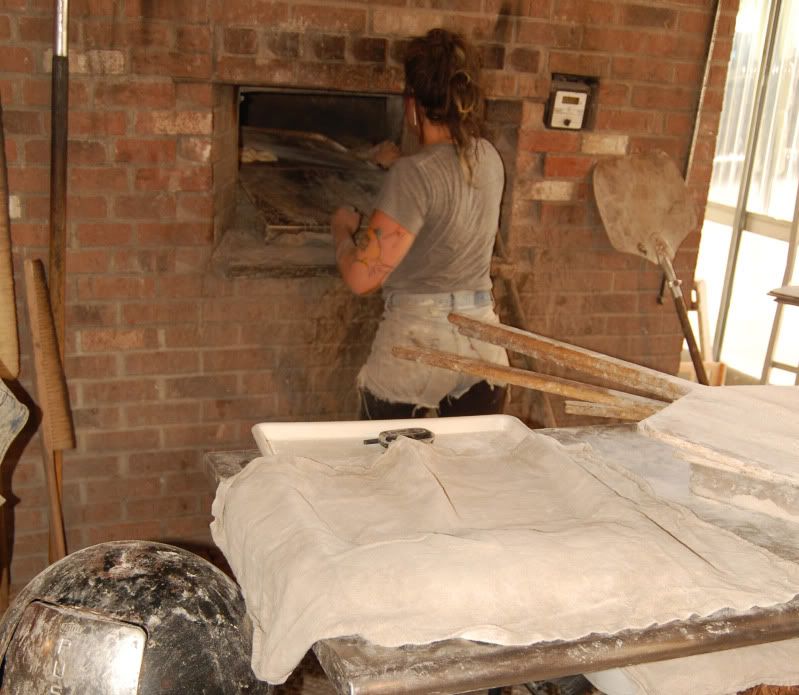
Then it was time to meet the cows. This is the milking room and when the cows are milked it is one of the few times they are indoors. Mainly they roam around outside, eating grass, getting frisky with one another and basically living the life mother nature intended. As for the getting frisky part, just that morning the farm welcomed a new calf to their herd.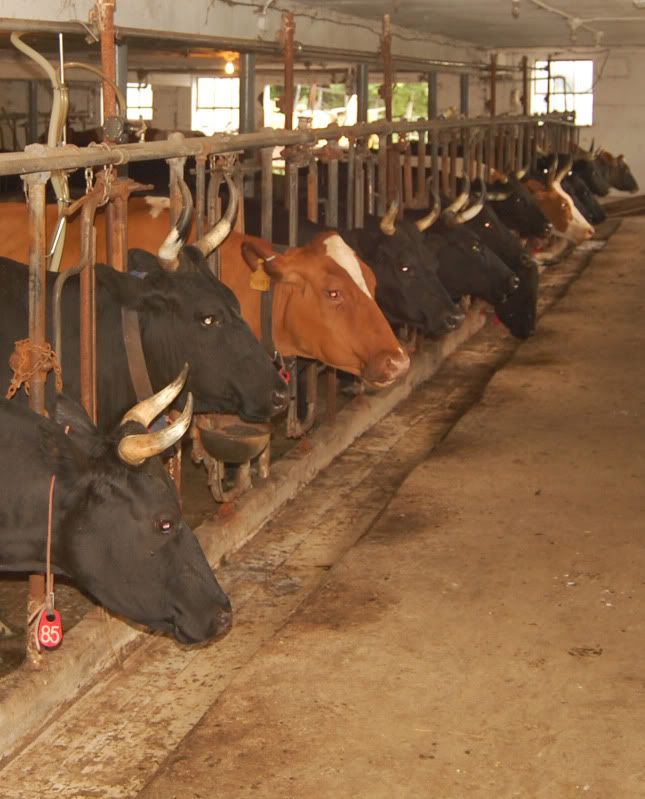
So they milk the cows and all the milk goes here, and then it is made into cheese. That day. No waiting around. No putting it in the fridge for tomorrow. That day. Because it tastes better, they said. At one point we saw Jonathan (farmer, husband of Nina and chief cheesemaker) skimming the cream off some of the milk. "That will become a cream sauce, probably for dinner," said Nina. And it took every ounce of energy not to fall to my knees and beg to be invited to supper that night.
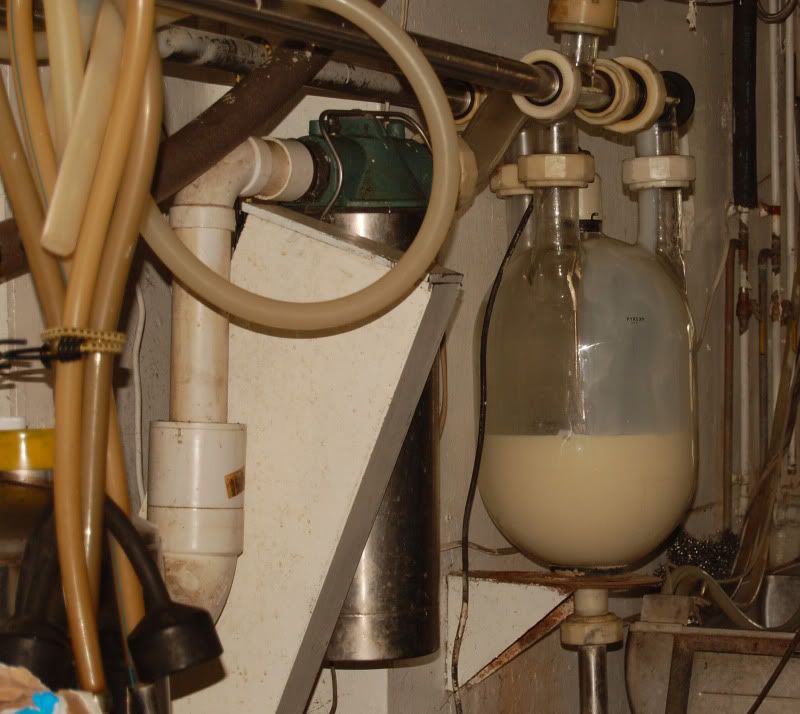 The whey, left over from the cheesemaking, feeds the pigs they have in a pasture, along with kitchen scraps and fattens the hogs. I kinda snickered to myself when another guy touring with us said "so then what do you do with them once they're fattened?" And Nina said "We harvest them." And then he said "But what do you do with them?" And then someone handed him a copy of Charlotte's Web and said "read this, but pretend Wilbur doesn't meet the spider."
The whey, left over from the cheesemaking, feeds the pigs they have in a pasture, along with kitchen scraps and fattens the hogs. I kinda snickered to myself when another guy touring with us said "so then what do you do with them once they're fattened?" And Nina said "We harvest them." And then he said "But what do you do with them?" And then someone handed him a copy of Charlotte's Web and said "read this, but pretend Wilbur doesn't meet the spider."
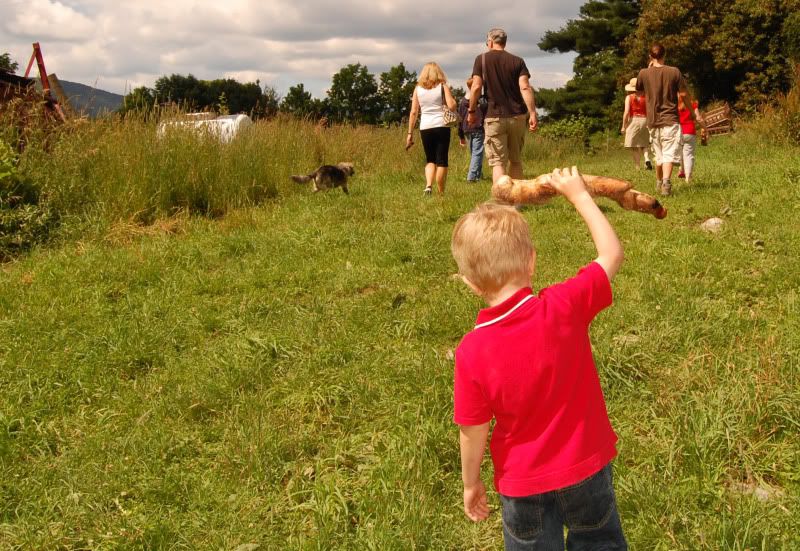
This little piggy had day old bread......

Back to cows....even their hides are treated naturally. Here, Nina shows a calfskin to us. The hide is preserved using vinegar (as opposed to formaldehyde). She made me smell it. I thought it would reek of....I don't know, something. But it smelled like nothing. Maybe a faint hint of leather?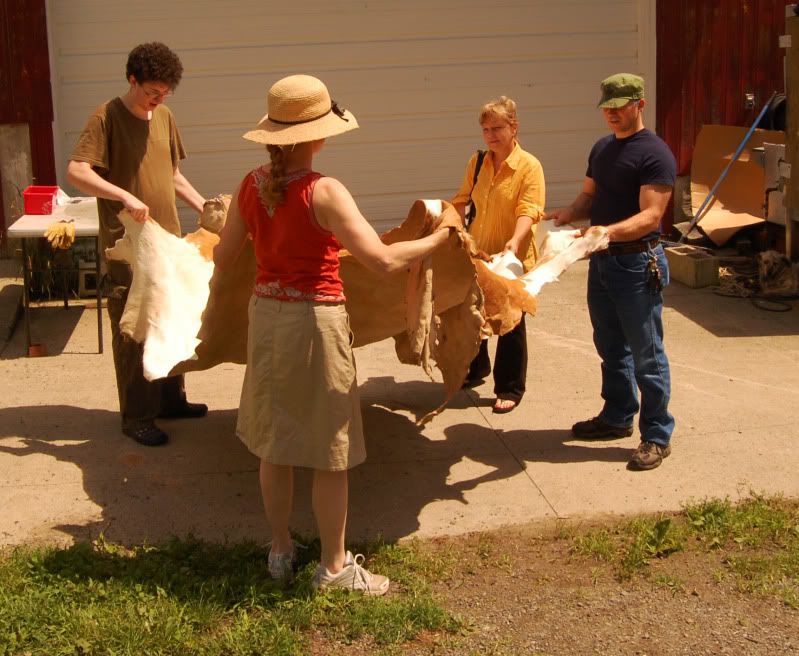
Over the 4th of July holiday we took the kids to visit Bobolink Dairy in New Jersey. I stumbled upon their website when I was searching for u-pick berry farms close to where we spend weekends. I revisited their site several times to read more about their operation. I had no idea they sold their cheeses and breads at the farmer's markets here in New York City and I had no idea they'd been written up in the New York Times several times. I liked what I read and was intrigued at the thought of taking their cheese and breadmaking workshop there. Mainly to improve my breadmaking skills and learning about cheese is a bonus, since I don't think I'll make my own but perhaps understanding how it is made will make me appreciate it more. Or at least I can contemplate it while I enjoy it with a nice glass of wine.
The workshops offered in the immediate future aren't convenient but a tour of the farm was. I thought it would be a nice way to acquaint myself with the place and the folks running it. I thought it would be nice for the kids to see a working farm and see that milk doesn't come from a plastic jug that is bought in the grocery store. I thought it would be a nice way to spend a morning.
We started out talking with a bread baker. This is Emily. She was in charge of baking the bread that day. The oven is heated by a wood fire, which is started the night before. At 10am, the temperature was down to 772 degrees. Emily told us about the breads they bake, where they get their flour, the difference between wheat and whole wheat and explained the structure of wheat and now this Brooklyn-born lady knows what chaff is. In the picture below Emily is putting ciabatta in the oven.

Then it was time to meet the cows. This is the milking room and when the cows are milked it is one of the few times they are indoors. Mainly they roam around outside, eating grass, getting frisky with one another and basically living the life mother nature intended. As for the getting frisky part, just that morning the farm welcomed a new calf to their herd.

So they milk the cows and all the milk goes here, and then it is made into cheese. That day. No waiting around. No putting it in the fridge for tomorrow. That day. Because it tastes better, they said. At one point we saw Jonathan (farmer, husband of Nina and chief cheesemaker) skimming the cream off some of the milk. "That will become a cream sauce, probably for dinner," said Nina. And it took every ounce of energy not to fall to my knees and beg to be invited to supper that night.
 The whey, left over from the cheesemaking, feeds the pigs they have in a pasture, along with kitchen scraps and fattens the hogs. I kinda snickered to myself when another guy touring with us said "so then what do you do with them once they're fattened?" And Nina said "We harvest them." And then he said "But what do you do with them?" And then someone handed him a copy of Charlotte's Web and said "read this, but pretend Wilbur doesn't meet the spider."
The whey, left over from the cheesemaking, feeds the pigs they have in a pasture, along with kitchen scraps and fattens the hogs. I kinda snickered to myself when another guy touring with us said "so then what do you do with them once they're fattened?" And Nina said "We harvest them." And then he said "But what do you do with them?" And then someone handed him a copy of Charlotte's Web and said "read this, but pretend Wilbur doesn't meet the spider."Actually, that didn't happen. Instead, Nina said, matter of factly "We eat them." And I didn't cringe. I thought I would. But I didn't because so far, this way of living, with the grass-fed cows and the artisinal cheese and the pigs that eat what would ordinarily go to waste, it makes sense. 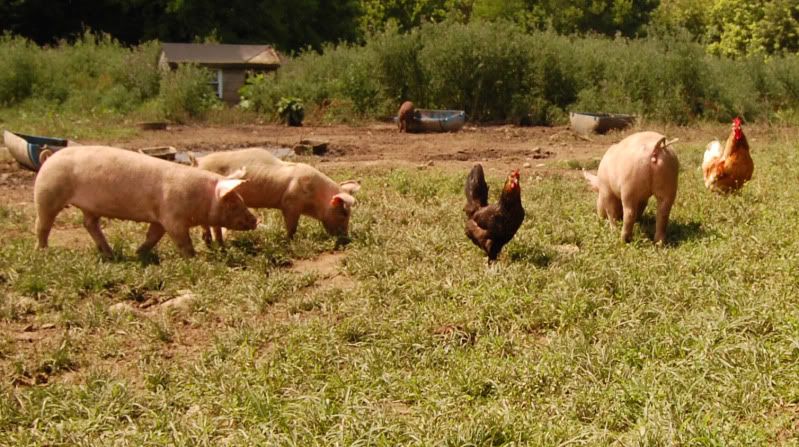 Oh, and those roosters you see in the picture above? They have a job on the farm, too. They eat the flies which would normally be present because of all the, you know, poop. And I can tell you there was nary a fly.
Oh, and those roosters you see in the picture above? They have a job on the farm, too. They eat the flies which would normally be present because of all the, you know, poop. And I can tell you there was nary a fly.

This little piggy had day old bread......
Then we were put to work. This is a small pen of ducks (Peking, I believe but don't quote me), which the farm adopted because another farm/family had changed their mind about the flock. They, too, earn their keep by eating bugs and grass. We moved their pen because they'd exhausted what was available to eat in that area. We all grabbed and edge and moved it over a bit. All the city people did their jobs well. No ducks escaped in the moving of this pen.

Back to cows....even their hides are treated naturally. Here, Nina shows a calfskin to us. The hide is preserved using vinegar (as opposed to formaldehyde). She made me smell it. I thought it would reek of....I don't know, something. But it smelled like nothing. Maybe a faint hint of leather?

Our tour concluded with a small discussion in farmyard. We talked about the farm, and how everyone and everything has a job to do. It perpetuates because they all rely on one another. I mentioned to Nina that I was glad I'd come to the farm, because I've had discussions with the kids about what we eat and it's important to see where it comes from, to have a relationship with your food. It was important for them to see this.
Then we talked about "stuff." Everyone likes stuff but we really don't need that much of it. The gospel preached that day was 'smaller quantity, higher quality.' It was all I could do to not high five her and yell "Amen, sister!"
Then Harry ran off to visit with the cats at the farmhouse.
I ended up in the farmstore where I bought two loaves of bread, a half pound of their cave aged cheddar and 10 eggs. Seems like an odd number but 10 was all they'd found that day and we gladly scooped them up. They were delicious.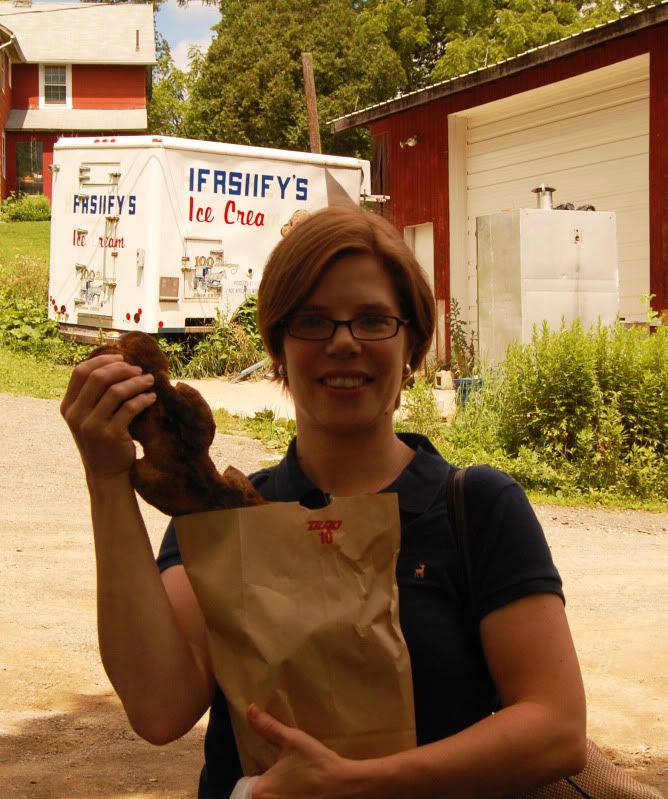
Then Harry ran off to visit with the cats at the farmhouse.

I ended up in the farmstore where I bought two loaves of bread, a half pound of their cave aged cheddar and 10 eggs. Seems like an odd number but 10 was all they'd found that day and we gladly scooped them up. They were delicious.




2 Comments:
that is so cool. great pics.
Thanks for the useful information. It looks like you haqd a good time, now get to work and bake me a loaf of bread, lol
Love you,
Mom
Post a Comment
<< Home